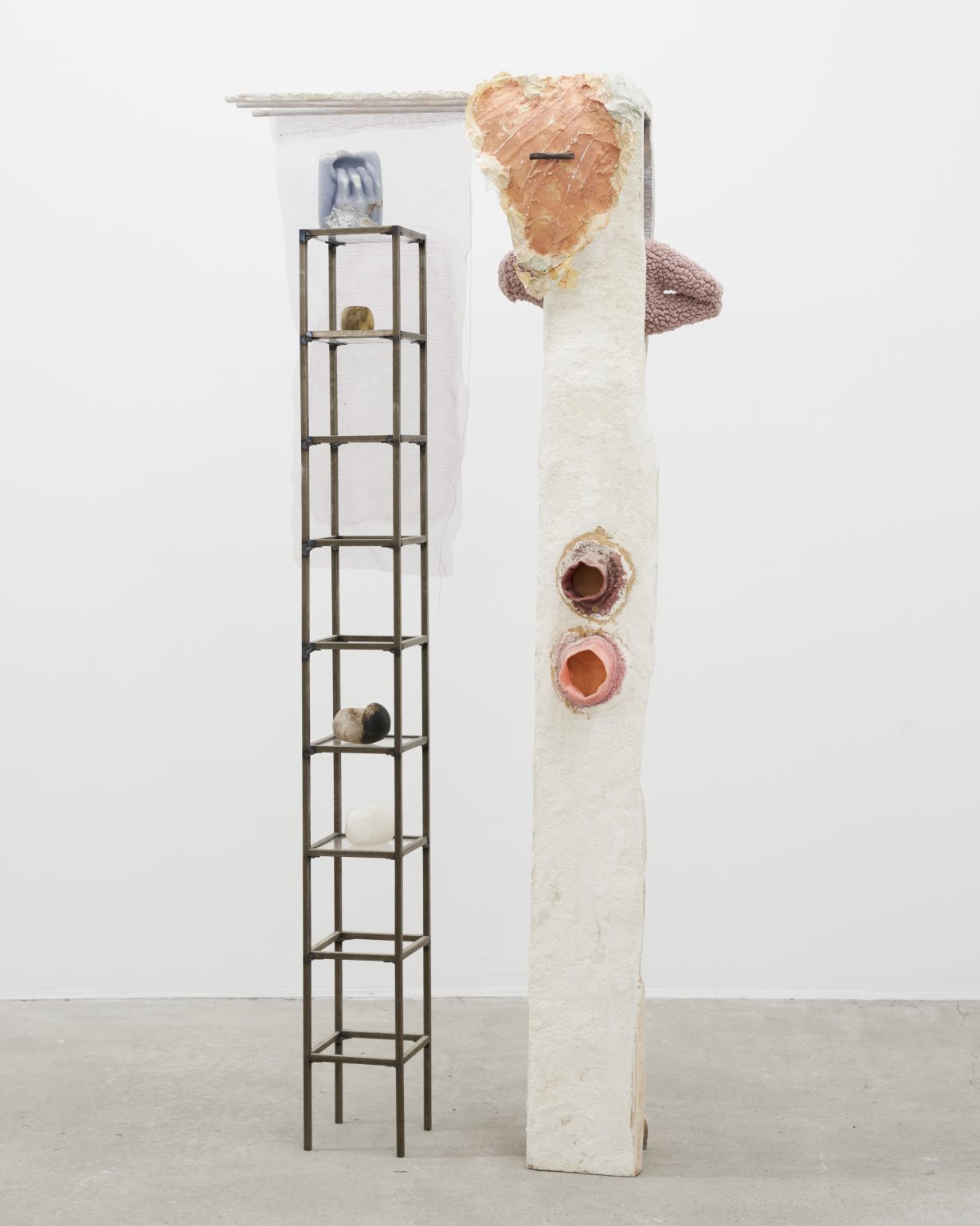Trick at Lyles & King, New York displays natural and industrial specimens as if they were fetish objects

Among the 16 sculptures and paintings in Trick is a tall assemblage that seems to be operating under the guise of home decor. Untitled (all works 2024) is composed of a metal shelving-unit and a wooden post. Palm-sized alabaster and soapstone trinkets line the shelves, and what appears to be a grimy stuffed animal is wedged in a niche in the wood. Between other elements in this sculpture, however, one observes a subtle show of force characteristic of Catalina Ouyang’s visual language: affixed to the post on a rust-coloured nail is a brittle piece of papier-mâché, roughly triangular, the size of a person’s face and coated in flesh-pink goop. This shell, suspended from a hole in its centre at the end of the unnecessarily long nail, is not so much secured to the wood as it is impaled in midair.
Like a wayward disciple of the sculptor Yeni Mao, whose diagrammatic assemblages often feature ceramics, volcanic rocks and stacked metal plates pierced by rods and chains, Ouyang displays natural and industrial specimens as if they were fetish objects. Unlike Mao’s antiseptic apparatuses, however, Ouyang’s metal implements are unclean and menacing. In a series of paintings titled Deed, for instance, a three-pronged rake looms over a nude, prone woman in a dark room. Elsewhere, the threat of violence is sublimated into erotic tension. In another untitled assemblage, on the floor at the centre of the gallery, an antler-shaped segment of apple wood cradling a two-pronged steel fork abuts a canvas bolster pillow. Standing on the pillow is a pair of cement-filled black boots, which are in turn bound together with twine and horsehair.

When, in Trick, the occasional human body appears alongside these ominous details, it evokes a narrative at once indelicate and introspective: as part of a third untitled assemblage that occupies the length of a wall in the gallery, a papier-mâché mannequin with an unformed face and a crudely textured, splotchy pink body lies supine over a wooden pallet. Across its chest, the dummy – vaguely female, adolescent – wears a bandeau, which the exhibition materials describe as a ‘training bra’ made from the T-shirts of the artist’s past partners. A cylindrical stump protruding from the figure’s left heel suggests dishevelment following a Cinderella-style flight; a hole in its hollow head alludes to injury as well as surgery. The same childlike character appears in Heads, another quasi-domestic assemblage composed of a midcentury display case stacked on a plywood box and a concrete plinth. Ouyang’s pink and pitted proxy hangs from the side of the wooden box with its knees tucked and its head inverted. Seven scythes protrude from oblong holes in the plywood, narrowly sparing the figure’s bare feet and white miniskirt. What is depicted in Heads, the exhibition suggests, is another brush with death in the plot of a hellish bildungsroman.
Ouyang’s assemblages are rivalled by their contribution to the gallery’s courtyard, Brank, a five-metre-tall steel sculpture shaped like a ‘scold’s bridle’, a seventeenth-century muzzle with a spiked bridle-bit used to gag and humiliate women, thus enforcing their subordination. With its smooth, soaring arches, Brank gestures vaguely to systemic oppression and kink in an equally noncommittal manner; noticeably, the spiked bridle-bit that once pressed on unruly tongues has been reduced to a small, blunt protrusion at the base of the colossus, hardly visible from afar. Whereas Ouyang’s pierced and bound assemblages possess complex formal tensions that convey anger and unease, their outdoor sculpture, forged from a single, uniform material, defangs a harrowing artefact in the process of monumentalising an obscure example of patriarchal violence.
Trick’s conceptual rigour, despite the diffuseness of its anchor piece, remains buttressed by the hand-me-down clothes and domestic wreckage of Ouyang’s assemblages, which lay bare the contentious personal and social narratives at the heart of their exhibition. Ultimately, the alchemical catharsis in these works is palpable even without reference to historical particulars. The friction generated between their broken and weathered parts offers a glimmer of unbridled rage, a resource too vital in the struggle for bodily autonomy for viewers to forget.
Trick at Lyles & King, New York, through 15 June